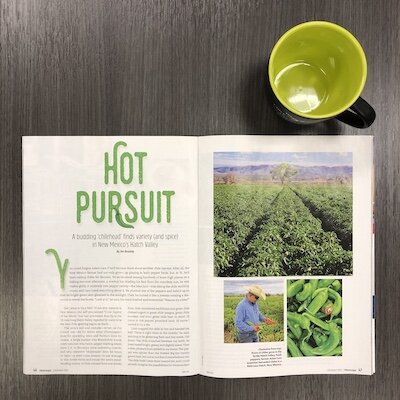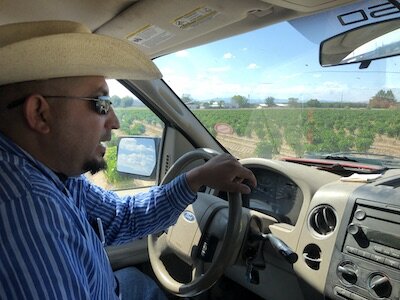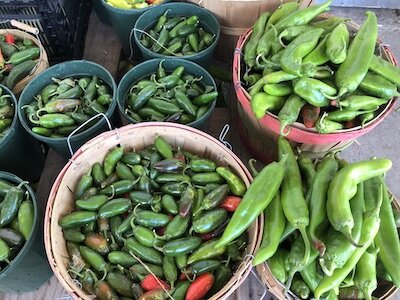A Chile-Pepper Pilgrimage to Hatch, New Mexico
By Jim Benning
Westways, July/August 2020
You could forgive Adam Lara if he’d grown blasé about another chile harvest. After all, the New Mexico farmer had not only grown up playing in leafy pepper fields, but at 35, he’d been raising chiles for decades. Yet as he stood among hundreds of knee-high plants on a baking summer afternoon, a cowboy hat shading his face from the merciless sun, he was visibly giddy. A relatively new pepper variety—the Miss Juni—was taking the chile world by storm, and Lara loved everything about it. He plucked one of the peppers and held it up so that its bright-green skin gleamed in the sunlight. Then he turned it like a jeweler rotating a diamond to reveal the facets. “Look at it,” he said, his voice hushed and reverential. “Wanna try a bite?”
Did I want to try a bite? I’d not only traveled to New Mexico, the self-proclaimed “Chile Capital of the World,” but had proceeded directly to the 10-mile-long Hatch Valley, regarded by many to be the best chile-growing region on Earth.
The area’s soil and climate—terroir, as the French say—do for chiles what Champagne’s does for sparkling wine and Parma’s does for cheese. It helps explain why #hatchchile trends every summer; why Hatch-pepper roasting events from L.A. to Brooklyn draw salivating crowds; and why obsessive “chileheads” drive for hours or days—or even cross oceans—to pay homage to this fertile valley and inhale the area’s mind-bending variety of chile-infused food and drinks, from chile-smothered enchiladas and green chile cheeseburgers to green chile lasagna, green chile sundaes, and even green chile beer. In short, I’d come to the pepper Promised Land. Of course, I wanted to try a bite.
Lara snapped the chile in two and handed me half. “Taste it right there in the middle,” he said, pointing to its glistening flesh and tiny seeds. I bit down. The chile crunched between my teeth. Its meat tasted bright, grassy, and slightly sweet. Then a slow, pleasant burn settled in my throat. The pepper was spicier than the NuMex Big Jim variety grown here, but not so hot that it overwhelmed me. The chile hadn’t even been roasted yet, and I could already imagine the possibilities for transcendent chiles rellenos and sublime green sauce. Needless to say, I planned to sample plenty of both during my weeklong visit—and a lot of other chile-infused dishes, too. At that point, I didn’t think I qualified as a chile pilgrim, but as John Steinbeck once wrote, “[W]e do not take a trip; a trip takes us.”
I’d arrived in the area in September 2019, a glorious time before the coronavirus pandemic, so I could attend the nearly 50-year-old Hatch Chile Festival, which by all accounts had played a key role in Hatch chiles’ rise to fame. Basing myself in Las Cruces—a city that lures heat seekers with a “Walk of Flame” restaurant guide, among other enticements—I headed 37 miles north toward the tiny farming village of Hatch, population roughly 1,680. I exited the highway, drove across the Rio Grande, which helps irrigate local chile fields, and followed a line of cars past storefronts decorated with red-chile ristras until I reached the festival grounds.
I stepped out of my car into a furnace. Even though Hatch Valley’s elevation is just over 4,000 feet, midday summer temperatures regularly climb into the upper 90s and beyond—a key factor in the chiles’ development. And yet by late morning, despite the intense heat, thousands of chile aficionados were already here—a testament to their devotion.
At first glance, the festival resembled a typical county fair. Lemonade stands were doing brisk business. Carnival rides whirred and spun. And under a corrugated metal roof, a local band was playing a bluesy cover of “Free Fallin’.” But then I encountered a long row of chile roasters. Presided over by guys wearing protective mittens, the big steel mesh cylinders rotated over hot flames. Inside, tumbling peppers crackled, sizzled, and popped. A smoky, earthy aroma permeated the air—the equivalent of incense in a cathedral for chileheads on pilgrimage to worship at the altar of Capsicum annuum. As I inhaled the otherworldly scent, I whispered my own prayer of gratitude.
All around me, devotees were loading bags of peppers onto wagons, or throwing the bulging burlap sacks over their shoulders. These considerable hauls would be frozen and used throughout the year for enchiladas, stews, chiles rellenos, moles, and, come Christmastime, tamales and menudo. One of the green-chile faithful, Elizabeth Montoya, had driven 85 miles from El Paso, Texas, to buy a 20-pound bag. “This is the best chile you can get,” she said. To be clear, there’s no single chile variety called Hatch. Rather, Hatch chiles are any chiles grown in the Hatch Valley. But true Hatch aficionados are generally referring to the long New Mexico varieties, from mild Rio Grande 21s and medium Sandias to hotter Lumbres and Miss Junis. In fact, almost everyone I spoke with had a favorite.
The chile festival has its rituals, and in the afternoon I gathered with others to watch the chile-eating contest. The Chile Queen and her Red and Green Princesses, all sporting bejeweled crowns and sashes, looked on as a dozen competitors gobbled chiles, seeds and all. All of that competitive eating was making me hungry, and afterward, I strolled booths and sampled chile-infused snacks, from piñon brittle to Polish sausages. But for all the novelty items I found, I imagined I’d encounter the finest expression of New Mexican cooking in the area’s longstanding restaurants.
So over the coming days, I went big. Just south of Las Cruces in historic Mesilla, where Billy the Kid was sentenced to hang and Pancho Villa once roamed, I inhaled fiery chiles rellenos. At Caliches Frozen Custard, a beloved institution on Las Cruces’ “Walk of Flame,” I devoured a frozen vanilla custard topped with salted pecans and diced green chiles—a concoction so creamy, spicy, and satisfying I wondered why it wasn’t a national obsession. And at Pecan Grill and Brewery, another “Walk of Flame” star, I washed down spicy green chile stew with a green chile lager—a house brew with defanged chiles and subtle grassy notes.
But my personal revelation came one afternoon at Valley Café, a mom-and-pop diner in Hatch village. I didn’t go in with high expectations. A lone picnic table and a faded ice dispenser sat out front, and inside, rancheras played and a sign said, “Things to do: seat yourself and pay at the register.” I sat by the window and ordered chicken enchiladas. The server posed the quintessential New Mexico question: “Red or green?” Eager to try both, I asked for the enchiladas Christmas-style—red sauce on one side, and green on the other.
My plate arrived with rice, pinto beans, and stacked enchiladas—flat corn tortillas with diced chicken, melted cheddar cheese, and a generous serving of both sauces on top. I tried the red side first. The sauce had an almost fire-engine hue and a mild earthiness to it. Then I tried a forkful of tortilla and melted cheese with the green and made sure to get plenty of diced chile. Almost immediately, a wave of tang and smoke hit me—the chile seemed amplified in the sauce, and as the bite went own, the heat singed my throat. I made my way deeper into the dish and beads of sweat gathered on my brow. I wiped perspiration from my eyelids. To any observer, I must have appeared to be in agony, and yet, I couldn’t get enough.
This, of course, explains the cult of the chile pepper. When heat receptors in our mouths detect the chile’s capsaicinoids, they send pain signals to the brain, which counteract the discomfort by releasing endorphins. Thanks to those chemicals—the same ones that fuel runners’ high—we feel elated, ecstatic, buzzed. We crave more. True believers become heat-seeking junkies. Pepper addicts. Chileheads. Indeed, when I asked the server at Valley Café for even more green sauce, I realized I, too, might be a chilehead.
Of course, you can find chile lovers all over the world these days, but it wasn’t always thus. While many consider peppers synonymous with fiery Sichuan or Punjabi cuisine, chiles are native to South America, and they didn’t even leave the Americas until after the first European explorers arrived about 500 years ago. And that, historians believe, is when the Spanish introduced chiles to New Mexico. But it wasn’t until the early 1900s that New Mexico’s chiles became a thriving cash crop—thanks to an immigrant from Chihuahua, Mexico.
New Mexico State University (NMSU) horticulture professor Fabian Garcia was among the 1894 graduating class of New Mexico College of Agriculture and Mechanic Arts, which became NMSU. The budding horticulturist spent years crossbreeding peppers to develop a mild chile that would appeal to spice-sensitive Anglo-Americans. He finally hit pay dirt by combining elements of the pasilla, chile negro, and chile Colorado. The resulting pepper, dubbed New Mexico No. 9, was officially released in 1921 and became the most popular variety in the United States for decades.
Since then, the university and the Hatch chile industry have had a symbiotic relationship, with NMSU horticulturists educating future chile farmers, developing popular new varietals, and generally fine-tuning the art and science of chile farming. It hasn’t hurt that NMSU resides in Las Cruces, less than an hour’s drive from the Hatch Valley. I wanted to understand why the area was so ideal for peppers, and why I’d been seeing reports that the local industry was in decline. So I headed to NMSU’s Skeen Hall and met Stephanie Walker, an associate professor and chile researcher with an expertise in plant genetics.
I asked Walker why the Hatch Valley is ideal for growing chiles. She noted the area’s high elevation, intense heat, dry weather, and slightly alkaline soil. “Some fruits and vegetables often produce more flavor compounds if they’re growing under stressful conditions,” she said. “We have a lot of stresses that are working on these plants, and I really think this brings out the best in them.” In fact, she recalled instances when farmers upgraded irrigation systems to improve their chile crop, only to find the opposite had occurred. “Suddenly,” she said, “you’re not water-stressing these plants and customers complain that their Sandia chile isn’t hot anymore.”
Despite that, I’d read that the amount of land in the Hatch Valley devoted to chile growing had declined precipitously in recent decades. Many were worried about the industry’s future. I asked Walker if she was. “On the smaller scale, we’re going to always have people growing chile for local restaurants and for die-hard chile folks here,” she said. (Like all New Mexicans I met, she used “chile”—singular—even when referring to many chiles.) “But for the larger scale, for canning it, freezing it, and commercial sales throughout the country or world, that’s where we need to be concerned, to make sure that we’ll be competitive with other countries.”
Indeed, since the North American Free Trade Agreement took effect in 1994, New Mexico’s chile farmers have struggled to compete with chile growers in Mexico, where labor costs are significantly lower. Some Hatch farmers had replaced chiles with more profitable pecans and other crops. To help reduce labor costs for chile farmers, Walker has been working to breed green chiles that can be harvested by machine—to date, green chiles have been harvested only by hand because attempts at machine-harvesting have mangled the peppers. (By contrast, red chiles are almost always machine harvested.)
Time will tell whether such methods can be developed. Meanwhile, not all chile experts agree on Hatch’s primacy, or worry about the chiles’ future. After I left NMSU, I chatted with Dave DeWitt, the “Pope of Peppers,” who lives in Albuquerque and who co-wrote The Complete Chile Pepper Book with former Chile Pepper Institute of NMSU director Paul Bosland. Branding locally grown peppers as “Hatch” is a clever a marketing tool, DeWitt said, but he insists that equally great New Mexico chiles are grown well beyond the area. “I’ve gone to Italy and have eaten chiles grown there from New Mexico seeds and they taste the same,” he said.
Of course, exceptional peppers grow in many places. New Mexicans are quick to point out that Emilio Ortega took chiles developed around Hatch and planted them in Anaheim, California, to grow his canned-chile empire. And across New Mexico, towns like Chimayó and Española are rightfully famous for their own locally raised chiles. But no place has achieved the same kind of name recognition as Hatch.
Near the end of my visit, during the height of the chile harvest, I drove Highway 187 out through the Hatch Valley, past shady pecan orchards and sprawling chile fields. I pulled over at Ogaz Farms, near a big sign advertising red and green chiles for sale. That’s where I met Lara, the 35-year-old farmer who plucked that first revelatory Miss Juni for me to try. Lara knew the valley as well as anyone. When I asked if he could imagine living anywhere else, he thought about it for a moment, tipped up his cowboy hat, and shook his head. “I like to be out in the fields,” he said. “This is God’s country.” And as a convert who was already plotting my own return pilgrimage, I couldn’t disagree.
Jim Benning is a Westways features editor. His reserves of frozen Hatch chiles helped him to endure the COVID-19 quarantine.



